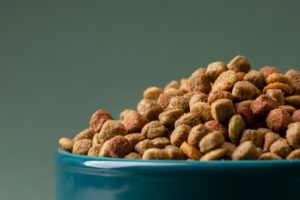Our furry companions bring endless joy into our lives, and spoiling them with delicious treats is a way to show our appreciation. But with store-bought options often riddled with mystery ingredients, fillers, and artificial flavors, many pet parents are turning to homemade alternatives.
This is where understanding vet-approved dog treat ingredients becomes crucial. By creating treats with safe and nutritious ingredients, you can ensure your pup enjoys tasty snacks while promoting their overall health and well-being.
This ultimate guide dives deep into the world of vet-approved dog treat ingredients, offering a comprehensive resource for pet parents who want to embark on the rewarding journey of homemade dog treat creation.
Why Opt for Homemade Dog Treats with Vet-Approved Ingredients?
Here are some compelling reasons to explore homemade dog treats using vet-approved dog treat ingredients:
- Control Over Ingredients: You have complete control over the ingredients used in your pup’s treats, ensuring they are free from artificial additives, preservatives, and unhealthy fillers.
- Dietary Needs: You can tailor-make treats to your dog’s specific dietary needs, whether they require grain-free, low-fat, or allergy-friendly options.
- Freshness & Quality: Homemade treats allow you to use fresh, high-quality ingredients, offering a superior alternative to store-bought options.
- Bonding Experience: Baking homemade treats with your dog can be a fun and rewarding bonding experience, strengthening your connection with your furry friend.
Essential Considerations Before You Begin:
Before diving headfirst into homemade dog treat creation, there are some essential considerations to keep in mind:
- Consult Your Veterinarian: Always discuss any dietary changes with your veterinarian before introducing new ingredients to your dog’s diet, especially if they have allergies or any underlying health conditions.
- Research Ingredients: Not all human foods are safe for dogs. Be sure to thoroughly research any ingredient before incorporating it into your dog’s treats.
- Moderation is Key: Even healthy treats should be given in moderation.
- Supervision is Important: Always supervise your dog when they enjoy homemade treats.
A Comprehensive List of Vet-Approved Dog Treat Ingredients:
Now, let’s explore a comprehensive list of vet-approved dog treat ingredients to inspire your homemade creations:
- Protein Sources:
Lean protein is essential for a dog’s diet. Here are some safe and healthy options:
- Cooked and shredded chicken breast or turkey breast
- Lean ground beef (drained of excess fat)
- Cooked salmon (excellent source of omega-3 fatty acids)
- Eggs (a good source of protein and biotin)
- Cottage cheese (low-fat option, high in protein and calcium)
- Carbohydrates:
Complex carbohydrates provide sustained energy for your pup. Consider these options:
- Whole wheat flour
- Brown rice flour
- Oat flour
- Rolled oats
- Sweet potato (excellent source of vitamins and fiber)
- Pumpkin puree (great for digestion and fiber)
- Healthy Fats:
A moderate amount of healthy fats is beneficial for your dog’s coat and overall health. Here are some safe choices:
- Coconut oil (solid at room temperature)
- Peanut butter (unsweetened, xylitol-free)
- Flaxseed meal (ground for better absorption)
- Fruits and Vegetables:
Fruits and vegetables offer a valuable source of vitamins, minerals, and antioxidants. However, proceed with caution and check with your veterinarian before introducing any new fruits or vegetables to your dog’s diet. Here are some generally safe options in moderation:
- Blueberries
- Cranberries
- Apples (peeled and cored)
- Bananas
- Carrots
- Green beans
- Natural Sweeteners:
Limit the use of sweeteners in your dog’s treats. Here are some safe options in very small amounts:
- Honey (raw and local)
- Bananas (natural sweetness)
- Other Safe Ingredients:
These additional ingredients can add flavor and texture to your dog’s treats:
- Unsweetened applesauce
- Broth (low-sodium)
- Plain yogurt (unsweetened)
Always Remember: “Safe for Humans” Doesn’t Equal “Safe for Dogs”
While some human foods are safe for dogs in moderation, it’s crucial to remember that many common ingredients can be toxic or cause digestive upset in our canine companions. Here are some ingredients to strictly avoid in homemade dog treats:
- Chocolate: Chocolate contains theobromine and caffeine, which are toxic to dogs. The severity of the reaction depends on the type and amount of chocolate ingested. Dark chocolate is the most dangerous, while white chocolate poses a lesser threat. Symptoms of chocolate poisoning in dogs can include vomiting, diarrhea, tremors, seizures, and even death.
- Grapes and Raisins: The exact reason why grapes and raisins are toxic to dogs remains unknown. However, they can cause kidney failure in some dogs, even in small amounts. It’s best to avoid these ingredients altogether.
- Onions, Garlic, and Leeks: These members of the allium family contain N-propyl disulfide, which can damage red blood cells in dogs and lead to anemia. Even small amounts of onions, garlic, or leeks can be harmful. Onion powder and garlic powder are concentrated forms and pose an even greater risk.
- Macadamia Nuts: While safe for humans, macadamia nuts can cause a variety of problems in dogs, including vomiting, diarrhea, weakness, tremors, and hyperthermia (elevated body temperature). The severity of the reaction can vary depending on the amount ingested. It’s best to keep all nuts out of reach of your dog and avoid using them as ingredients.
- Xylitol: Xylitol is a sugar alcohol commonly used as a sugar substitute in sugar-free products, including chewing gum, candy, and some baked goods. Xylitol can cause a rapid drop in blood sugar in dogs, leading to weakness, seizures, and liver damage. Be sure to check labels carefully and avoid any products containing xylitol when baking for your pup.
- Artificial Sweeteners and Flavors: While not necessarily toxic, artificial sweeteners and flavors offer no nutritional value and can potentially upset your dog’s stomach. It’s best to stick with natural ingredients when making homemade dog treats.
- Cooked Bones: Cooked bones can become brittle and splinter, posing a choking hazard and potentially causing internal injuries. Stick with raw bones appropriate for your dog’s size and chewing habits.
- Fatty Meats and Skin: While dogs are omnivores and can benefit from some fat in their diet, excessive fat can lead to pancreatitis, a painful inflammation of the pancreas. Avoid using fatty meats and skin as ingredients in your dog’s treats. Lean meats like chicken or turkey breast are safer options.
- Dairy Products: Many dogs are lactose intolerant, meaning they lack the enzyme needed to digest lactose (milk sugar) in dairy products. Consuming dairy can cause digestive issues like gas, bloating, diarrhea, and vomiting. Opt for dog-safe alternatives like lactose-free yogurt or small amounts of plain cheese as an occasional treat (with veterinary approval).
- Alcohol: Even small amounts of alcohol can be toxic to dogs. Avoid using alcoholic beverages or extracts as ingredients in your dog’s treats.
Safe Storage Tips for Homemade Dog Treats:
Once you’ve created your delicious and nutritious dog treats with vet-approved dog treat ingredients, proper storage is essential:
- Cool Completely: Allow treats to cool completely before storing them.
- Airtight Container: Store treats in an airtight container to prevent them from drying out or becoming stale.
- Refrigerator or Freezer: Depending on the recipe, store treats in the refrigerator for up to a week or freeze for longer storage (up to a month).
Conclusion:
By understanding vet-approved dog treat ingredients and following these safe practices, you can embark on a rewarding journey of creating homemade treats your pup will love. Remember, consult your veterinarian before introducing any new ingredients, prioritize fresh and high-quality options, and prioritize moderation when offering treats to your furry best friend.
With a little creativity and these valuable guidelines, you can create scrumptious and healthy snacks that will show your dog you care while promoting their overall well-being!
At Truffle Paws, we’re here to simplify this process for you. Our goal is to select the best insurance plan for your dog that keeps your dog healthy and ensures you’re ready for the financial responsibilities. Let’s connect today and protect your dog.







